Amsterdam University CRM Report: Tesco's CRM Analysis (2020)
VerifiedAdded on 2020/12/08
|31
|8538
|86
Report
AI Summary
This report, prepared for a Customer Relationship Management course at Amsterdam University of Applied Sciences, provides a comprehensive analysis of Tesco's CRM system. It begins with an introduction to the company, its background, methodology, and research questions. The report then delves into Tesco's current CRM strategy, including its elements, customer analytics, and customer interaction methods. It identifies drawbacks such as checkout counter issues, multichannel approach challenges, and food hygiene concerns. The report proposes recommendations for improving the CRM strategy, including implementation levels and customer analytics enhancements. It also outlines an implementation schedule. Findings and analysis based on interviews with Tesco employees are presented, offering insights into Tesco's customer relationship management practices. The report concludes with an in-depth discussion of the findings and analysis, providing a detailed understanding of Tesco's CRM performance and areas for improvement.
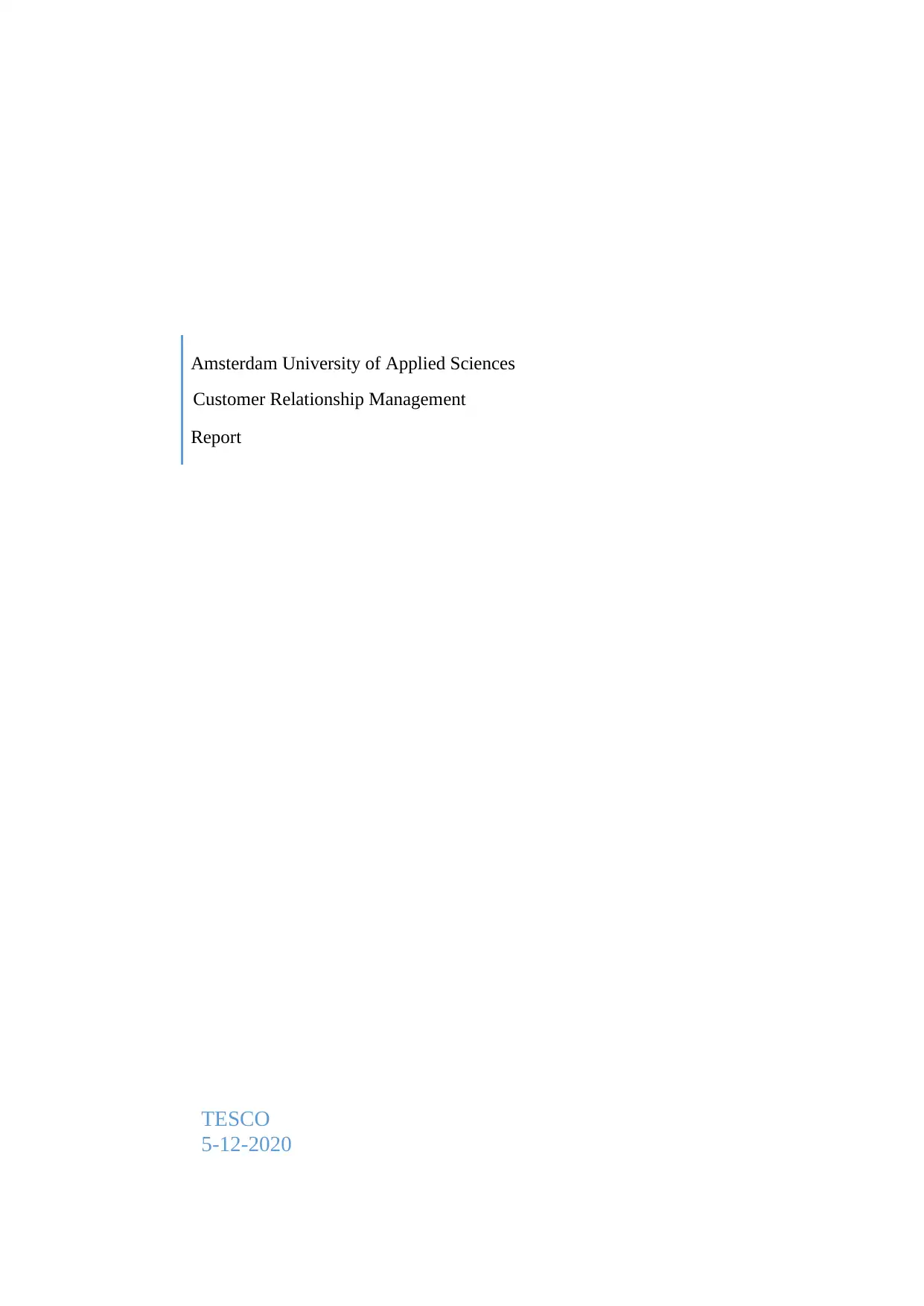
Amsterdam University of Applied Sciences
Customer Relationship Management
Report
TESCO
5-12-2020
Customer Relationship Management
Report
TESCO
5-12-2020
Paraphrase This Document
Need a fresh take? Get an instant paraphrase of this document with our AI Paraphraser
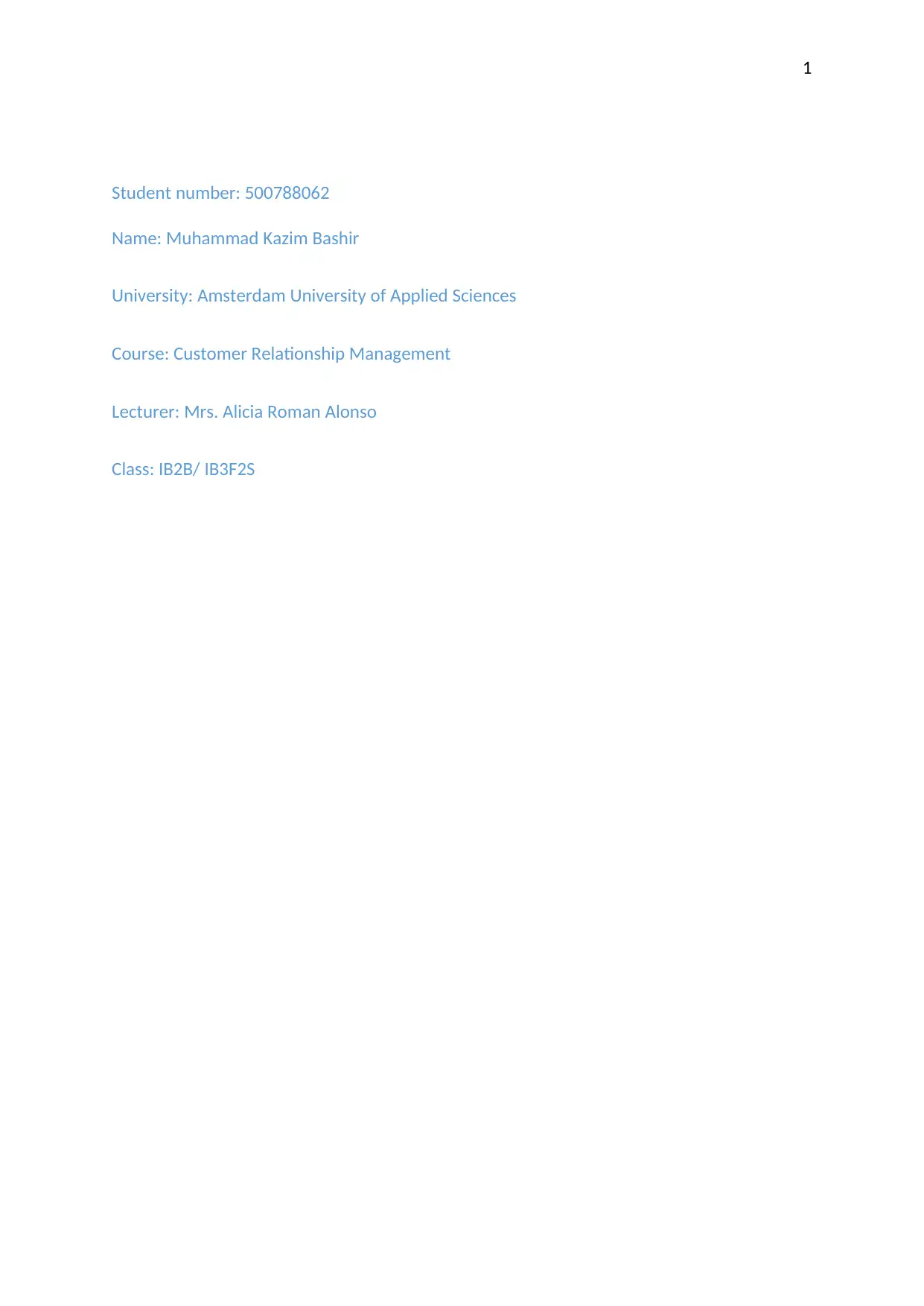
1
Student number: 500788062
Name: Muhammad Kazim Bashir
University: Amsterdam University of Applied Sciences
Course: Customer Relationship Management
Lecturer: Mrs. Alicia Roman Alonso
Class: IB2B/ IB3F2S
Student number: 500788062
Name: Muhammad Kazim Bashir
University: Amsterdam University of Applied Sciences
Course: Customer Relationship Management
Lecturer: Mrs. Alicia Roman Alonso
Class: IB2B/ IB3F2S
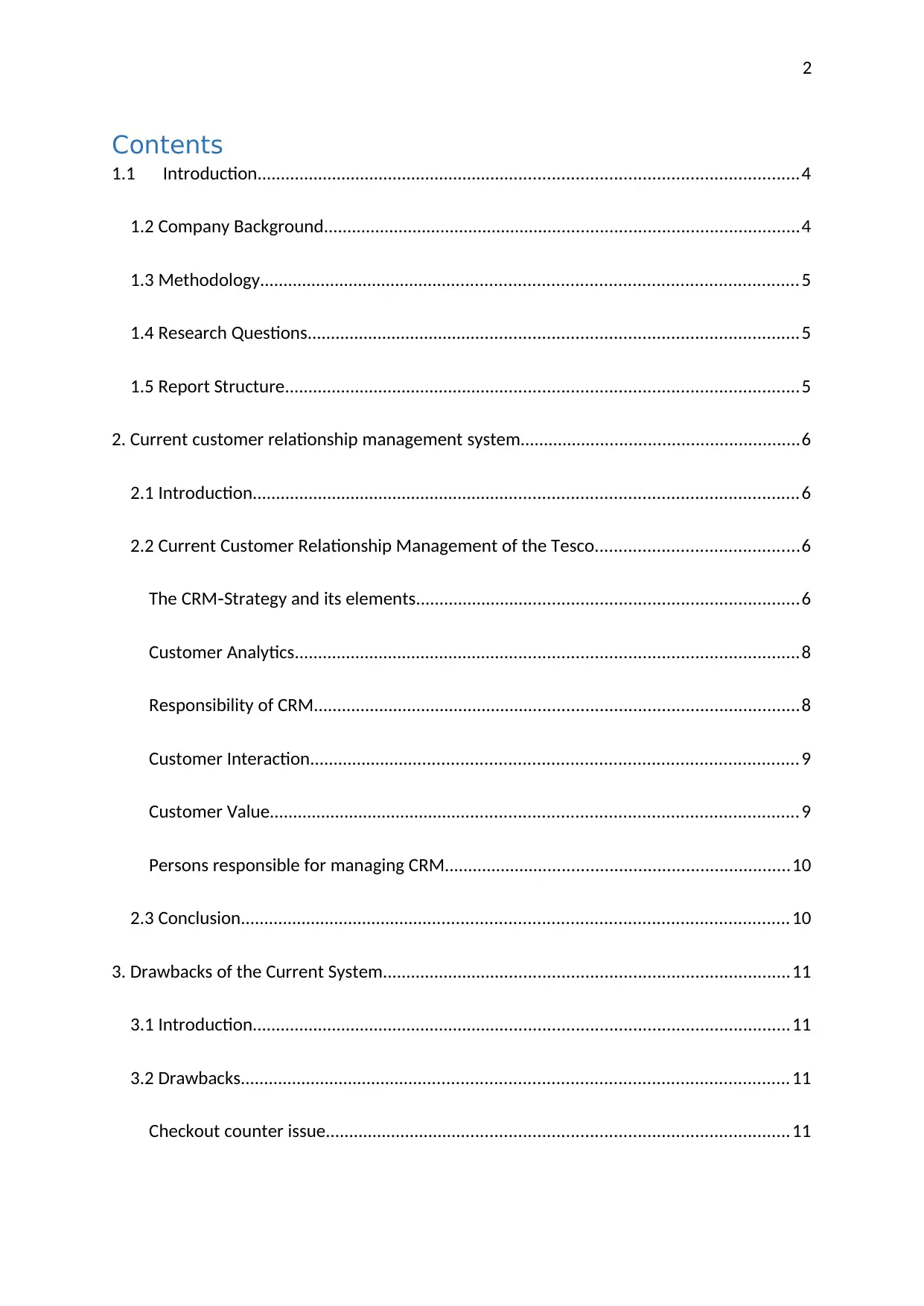
2
Contents
1.1 Introduction...................................................................................................................4
1.2 Company Background.....................................................................................................4
1.3 Methodology..................................................................................................................5
1.4 Research Questions........................................................................................................5
1.5 Report Structure.............................................................................................................5
2. Current customer relationship management system...........................................................6
2.1 Introduction....................................................................................................................6
2.2 Current Customer Relationship Management of the Tesco...........................................6
The CRM Strategy‐ and its elements.................................................................................6
Customer Analytics...........................................................................................................8
Responsibility of CRM.......................................................................................................8
Customer Interaction....................................................................................................... 9
Customer Value................................................................................................................9
Persons responsible for managing CRM.........................................................................10
2.3 Conclusion.................................................................................................................... 10
3. Drawbacks of the Current System......................................................................................11
3.1 Introduction..................................................................................................................11
3.2 Drawbacks.................................................................................................................... 11
Checkout counter issue..................................................................................................11
Contents
1.1 Introduction...................................................................................................................4
1.2 Company Background.....................................................................................................4
1.3 Methodology..................................................................................................................5
1.4 Research Questions........................................................................................................5
1.5 Report Structure.............................................................................................................5
2. Current customer relationship management system...........................................................6
2.1 Introduction....................................................................................................................6
2.2 Current Customer Relationship Management of the Tesco...........................................6
The CRM Strategy‐ and its elements.................................................................................6
Customer Analytics...........................................................................................................8
Responsibility of CRM.......................................................................................................8
Customer Interaction....................................................................................................... 9
Customer Value................................................................................................................9
Persons responsible for managing CRM.........................................................................10
2.3 Conclusion.................................................................................................................... 10
3. Drawbacks of the Current System......................................................................................11
3.1 Introduction..................................................................................................................11
3.2 Drawbacks.................................................................................................................... 11
Checkout counter issue..................................................................................................11
⊘ This is a preview!⊘
Do you want full access?
Subscribe today to unlock all pages.

Trusted by 1+ million students worldwide
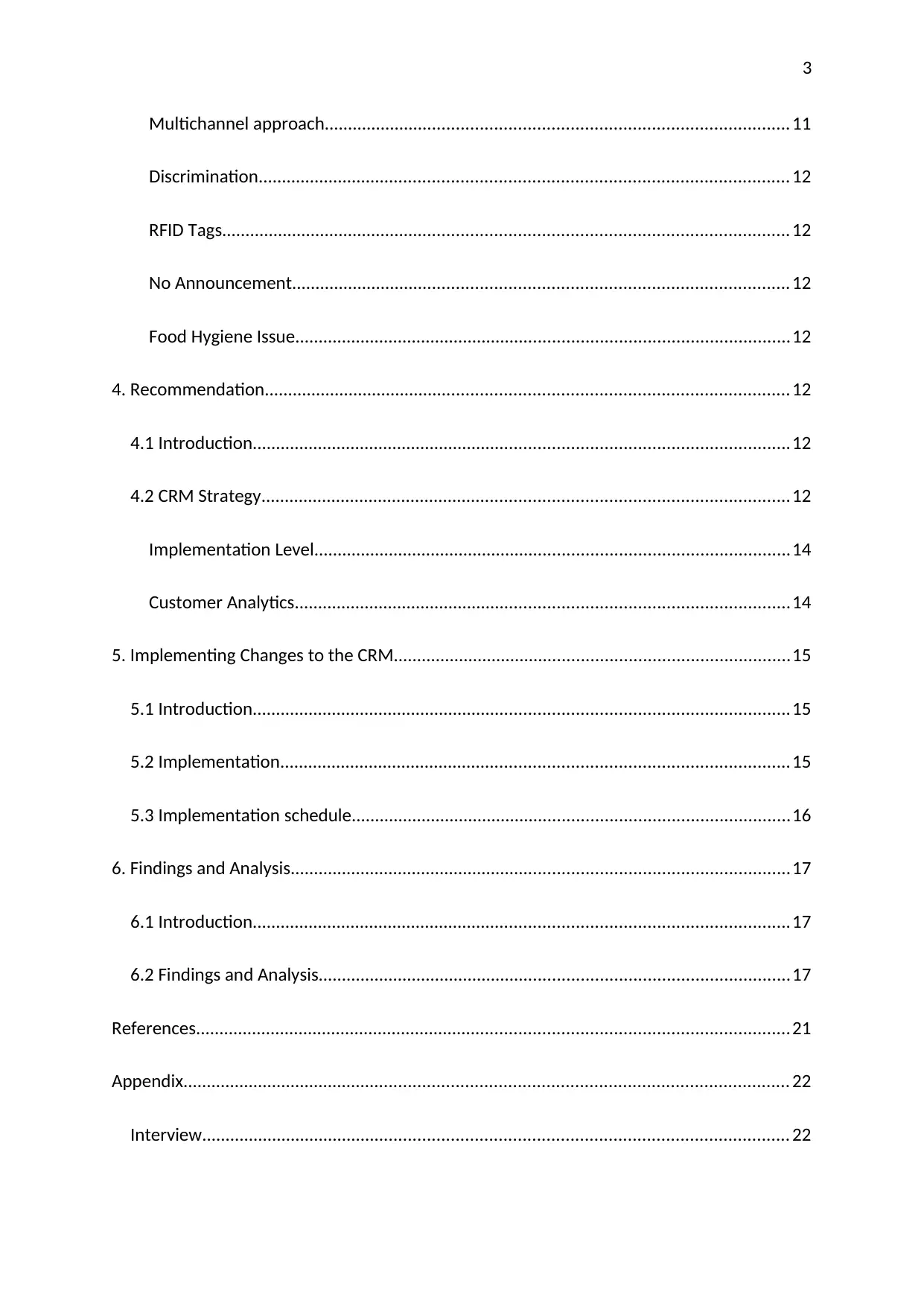
3
Multichannel approach.................................................................................................. 11
Discrimination................................................................................................................ 12
RFID Tags........................................................................................................................ 12
No Announcement......................................................................................................... 12
Food Hygiene Issue.........................................................................................................12
4. Recommendation...............................................................................................................12
4.1 Introduction..................................................................................................................12
4.2 CRM Strategy................................................................................................................12
Implementation Level.....................................................................................................14
Customer Analytics.........................................................................................................14
5. Implementing Changes to the CRM....................................................................................15
5.1 Introduction..................................................................................................................15
5.2 Implementation............................................................................................................15
5.3 Implementation schedule.............................................................................................16
6. Findings and Analysis..........................................................................................................17
6.1 Introduction..................................................................................................................17
6.2 Findings and Analysis....................................................................................................17
References..............................................................................................................................21
Appendix................................................................................................................................ 22
Interview............................................................................................................................ 22
Multichannel approach.................................................................................................. 11
Discrimination................................................................................................................ 12
RFID Tags........................................................................................................................ 12
No Announcement......................................................................................................... 12
Food Hygiene Issue.........................................................................................................12
4. Recommendation...............................................................................................................12
4.1 Introduction..................................................................................................................12
4.2 CRM Strategy................................................................................................................12
Implementation Level.....................................................................................................14
Customer Analytics.........................................................................................................14
5. Implementing Changes to the CRM....................................................................................15
5.1 Introduction..................................................................................................................15
5.2 Implementation............................................................................................................15
5.3 Implementation schedule.............................................................................................16
6. Findings and Analysis..........................................................................................................17
6.1 Introduction..................................................................................................................17
6.2 Findings and Analysis....................................................................................................17
References..............................................................................................................................21
Appendix................................................................................................................................ 22
Interview............................................................................................................................ 22
Paraphrase This Document
Need a fresh take? Get an instant paraphrase of this document with our AI Paraphraser

4
1. Introduction
This paper is formulated for the course of Customer Relationship Management. It is created
for gaining the knowledge regarding the Customer Relationship Management within the real
business setting course. The aim of this report is to make the student independent
consultant of the organisation and providing the recommendation on how the CRM system
can be improve. This report aids in gaining an insight into the extent of the Tesco for
managing and developing the consumer relation, the drawbacks of how the Tesco at
present manages and develops consumer relations, drawbacks of the current approach of
Tesco, and the nature of the Tesco and its environment, in what way the Tesco should
develop and manage relationships with customers using CRM, in what way the Tesco should
execute the essential changes in the customer relationship managing approach to shift from
the current to the anticipated approach for managing and developing relationships with
customers.
1.2 Company Background
The company which is selected for evaluating the CRM system is the Tesco. Tesco is one of
the prominent retail companies of the UK in terms of marketing share and increasing
international sales. From recent years, various fierce forces of competition have been
experienced by Tesco and it is seen that new competitors are increasing (Bai, and Qin, 2016,
pp.112-124). Tesco is regarded as the grocery store champion within the UK. In the
beginning, the company started trading in the drinks and food and the company has
managed to bring diversification into various vital businesses such as clothing monetary and
financial services, and consumer electronics (Wood, Coe, and Wrigley, 2016, pp.475-495).
The core aims of the Tesco includes building continuous customer relationship and expand
itself on the consumer base, assess both the values and the needs as of the consumer for
increasing the chances of revenue growth by fulfilling the needs the consumer, recognizing
1. Introduction
This paper is formulated for the course of Customer Relationship Management. It is created
for gaining the knowledge regarding the Customer Relationship Management within the real
business setting course. The aim of this report is to make the student independent
consultant of the organisation and providing the recommendation on how the CRM system
can be improve. This report aids in gaining an insight into the extent of the Tesco for
managing and developing the consumer relation, the drawbacks of how the Tesco at
present manages and develops consumer relations, drawbacks of the current approach of
Tesco, and the nature of the Tesco and its environment, in what way the Tesco should
develop and manage relationships with customers using CRM, in what way the Tesco should
execute the essential changes in the customer relationship managing approach to shift from
the current to the anticipated approach for managing and developing relationships with
customers.
1.2 Company Background
The company which is selected for evaluating the CRM system is the Tesco. Tesco is one of
the prominent retail companies of the UK in terms of marketing share and increasing
international sales. From recent years, various fierce forces of competition have been
experienced by Tesco and it is seen that new competitors are increasing (Bai, and Qin, 2016,
pp.112-124). Tesco is regarded as the grocery store champion within the UK. In the
beginning, the company started trading in the drinks and food and the company has
managed to bring diversification into various vital businesses such as clothing monetary and
financial services, and consumer electronics (Wood, Coe, and Wrigley, 2016, pp.475-495).
The core aims of the Tesco includes building continuous customer relationship and expand
itself on the consumer base, assess both the values and the needs as of the consumer for
increasing the chances of revenue growth by fulfilling the needs the consumer, recognizing
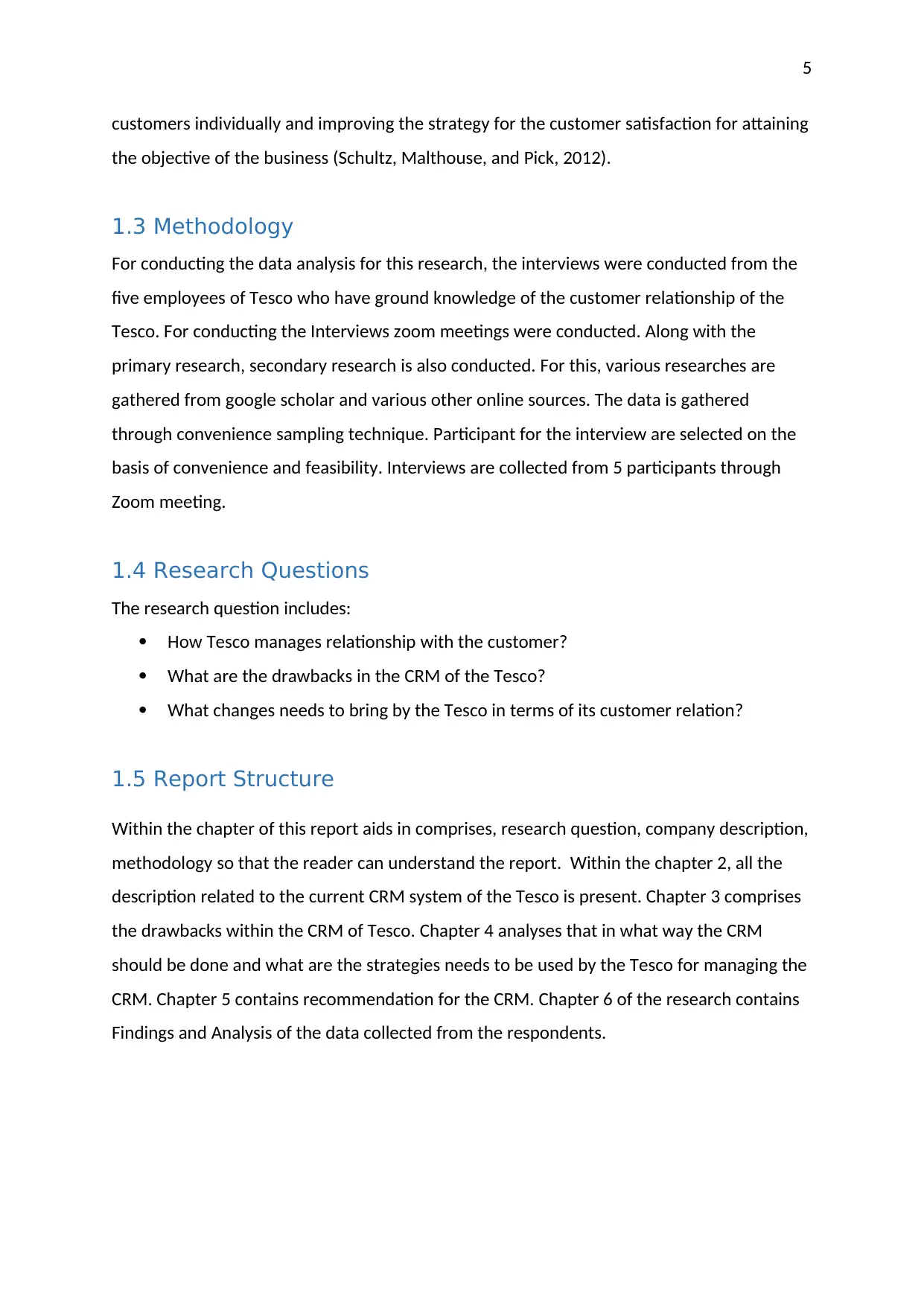
5
customers individually and improving the strategy for the customer satisfaction for attaining
the objective of the business (Schultz, Malthouse, and Pick, 2012).
1.3 Methodology
For conducting the data analysis for this research, the interviews were conducted from the
five employees of Tesco who have ground knowledge of the customer relationship of the
Tesco. For conducting the Interviews zoom meetings were conducted. Along with the
primary research, secondary research is also conducted. For this, various researches are
gathered from google scholar and various other online sources. The data is gathered
through convenience sampling technique. Participant for the interview are selected on the
basis of convenience and feasibility. Interviews are collected from 5 participants through
Zoom meeting.
1.4 Research Questions
The research question includes:
How Tesco manages relationship with the customer?
What are the drawbacks in the CRM of the Tesco?
What changes needs to bring by the Tesco in terms of its customer relation?
1.5 Report Structure
Within the chapter of this report aids in comprises, research question, company description,
methodology so that the reader can understand the report. Within the chapter 2, all the
description related to the current CRM system of the Tesco is present. Chapter 3 comprises
the drawbacks within the CRM of Tesco. Chapter 4 analyses that in what way the CRM
should be done and what are the strategies needs to be used by the Tesco for managing the
CRM. Chapter 5 contains recommendation for the CRM. Chapter 6 of the research contains
Findings and Analysis of the data collected from the respondents.
customers individually and improving the strategy for the customer satisfaction for attaining
the objective of the business (Schultz, Malthouse, and Pick, 2012).
1.3 Methodology
For conducting the data analysis for this research, the interviews were conducted from the
five employees of Tesco who have ground knowledge of the customer relationship of the
Tesco. For conducting the Interviews zoom meetings were conducted. Along with the
primary research, secondary research is also conducted. For this, various researches are
gathered from google scholar and various other online sources. The data is gathered
through convenience sampling technique. Participant for the interview are selected on the
basis of convenience and feasibility. Interviews are collected from 5 participants through
Zoom meeting.
1.4 Research Questions
The research question includes:
How Tesco manages relationship with the customer?
What are the drawbacks in the CRM of the Tesco?
What changes needs to bring by the Tesco in terms of its customer relation?
1.5 Report Structure
Within the chapter of this report aids in comprises, research question, company description,
methodology so that the reader can understand the report. Within the chapter 2, all the
description related to the current CRM system of the Tesco is present. Chapter 3 comprises
the drawbacks within the CRM of Tesco. Chapter 4 analyses that in what way the CRM
should be done and what are the strategies needs to be used by the Tesco for managing the
CRM. Chapter 5 contains recommendation for the CRM. Chapter 6 of the research contains
Findings and Analysis of the data collected from the respondents.
⊘ This is a preview!⊘
Do you want full access?
Subscribe today to unlock all pages.

Trusted by 1+ million students worldwide
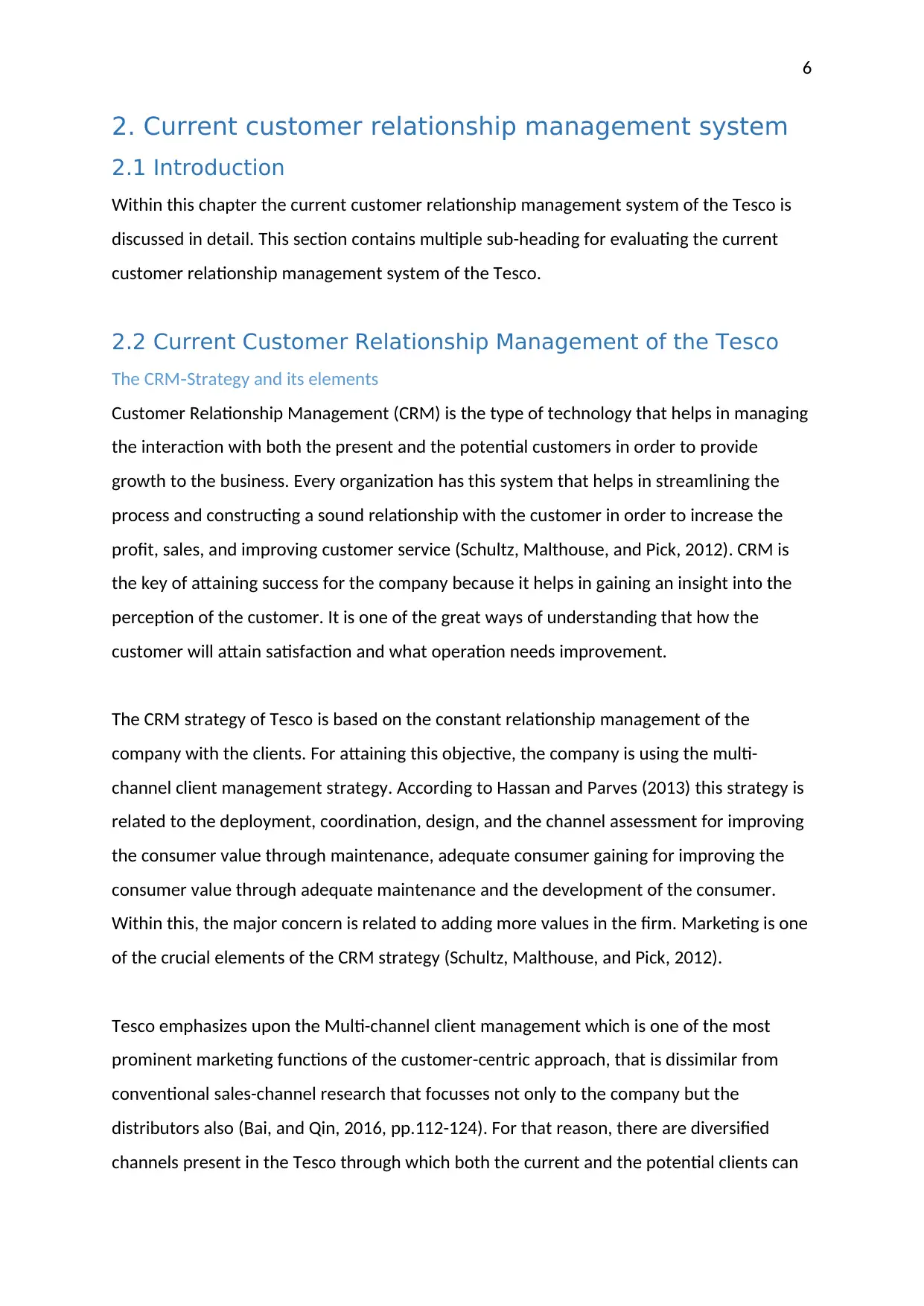
6
2. Current customer relationship management system
2.1 Introduction
Within this chapter the current customer relationship management system of the Tesco is
discussed in detail. This section contains multiple sub-heading for evaluating the current
customer relationship management system of the Tesco.
2.2 Current Customer Relationship Management of the Tesco
The CRM Strategy‐ and its elements
Customer Relationship Management (CRM) is the type of technology that helps in managing
the interaction with both the present and the potential customers in order to provide
growth to the business. Every organization has this system that helps in streamlining the
process and constructing a sound relationship with the customer in order to increase the
profit, sales, and improving customer service (Schultz, Malthouse, and Pick, 2012). CRM is
the key of attaining success for the company because it helps in gaining an insight into the
perception of the customer. It is one of the great ways of understanding that how the
customer will attain satisfaction and what operation needs improvement.
The CRM strategy of Tesco is based on the constant relationship management of the
company with the clients. For attaining this objective, the company is using the multi-
channel client management strategy. According to Hassan and Parves (2013) this strategy is
related to the deployment, coordination, design, and the channel assessment for improving
the consumer value through maintenance, adequate consumer gaining for improving the
consumer value through adequate maintenance and the development of the consumer.
Within this, the major concern is related to adding more values in the firm. Marketing is one
of the crucial elements of the CRM strategy (Schultz, Malthouse, and Pick, 2012).
Tesco emphasizes upon the Multi-channel client management which is one of the most
prominent marketing functions of the customer-centric approach, that is dissimilar from
conventional sales-channel research that focusses not only to the company but the
distributors also (Bai, and Qin, 2016, pp.112-124). For that reason, there are diversified
channels present in the Tesco through which both the current and the potential clients can
2. Current customer relationship management system
2.1 Introduction
Within this chapter the current customer relationship management system of the Tesco is
discussed in detail. This section contains multiple sub-heading for evaluating the current
customer relationship management system of the Tesco.
2.2 Current Customer Relationship Management of the Tesco
The CRM Strategy‐ and its elements
Customer Relationship Management (CRM) is the type of technology that helps in managing
the interaction with both the present and the potential customers in order to provide
growth to the business. Every organization has this system that helps in streamlining the
process and constructing a sound relationship with the customer in order to increase the
profit, sales, and improving customer service (Schultz, Malthouse, and Pick, 2012). CRM is
the key of attaining success for the company because it helps in gaining an insight into the
perception of the customer. It is one of the great ways of understanding that how the
customer will attain satisfaction and what operation needs improvement.
The CRM strategy of Tesco is based on the constant relationship management of the
company with the clients. For attaining this objective, the company is using the multi-
channel client management strategy. According to Hassan and Parves (2013) this strategy is
related to the deployment, coordination, design, and the channel assessment for improving
the consumer value through maintenance, adequate consumer gaining for improving the
consumer value through adequate maintenance and the development of the consumer.
Within this, the major concern is related to adding more values in the firm. Marketing is one
of the crucial elements of the CRM strategy (Schultz, Malthouse, and Pick, 2012).
Tesco emphasizes upon the Multi-channel client management which is one of the most
prominent marketing functions of the customer-centric approach, that is dissimilar from
conventional sales-channel research that focusses not only to the company but the
distributors also (Bai, and Qin, 2016, pp.112-124). For that reason, there are diversified
channels present in the Tesco through which both the current and the potential clients can
Paraphrase This Document
Need a fresh take? Get an instant paraphrase of this document with our AI Paraphraser
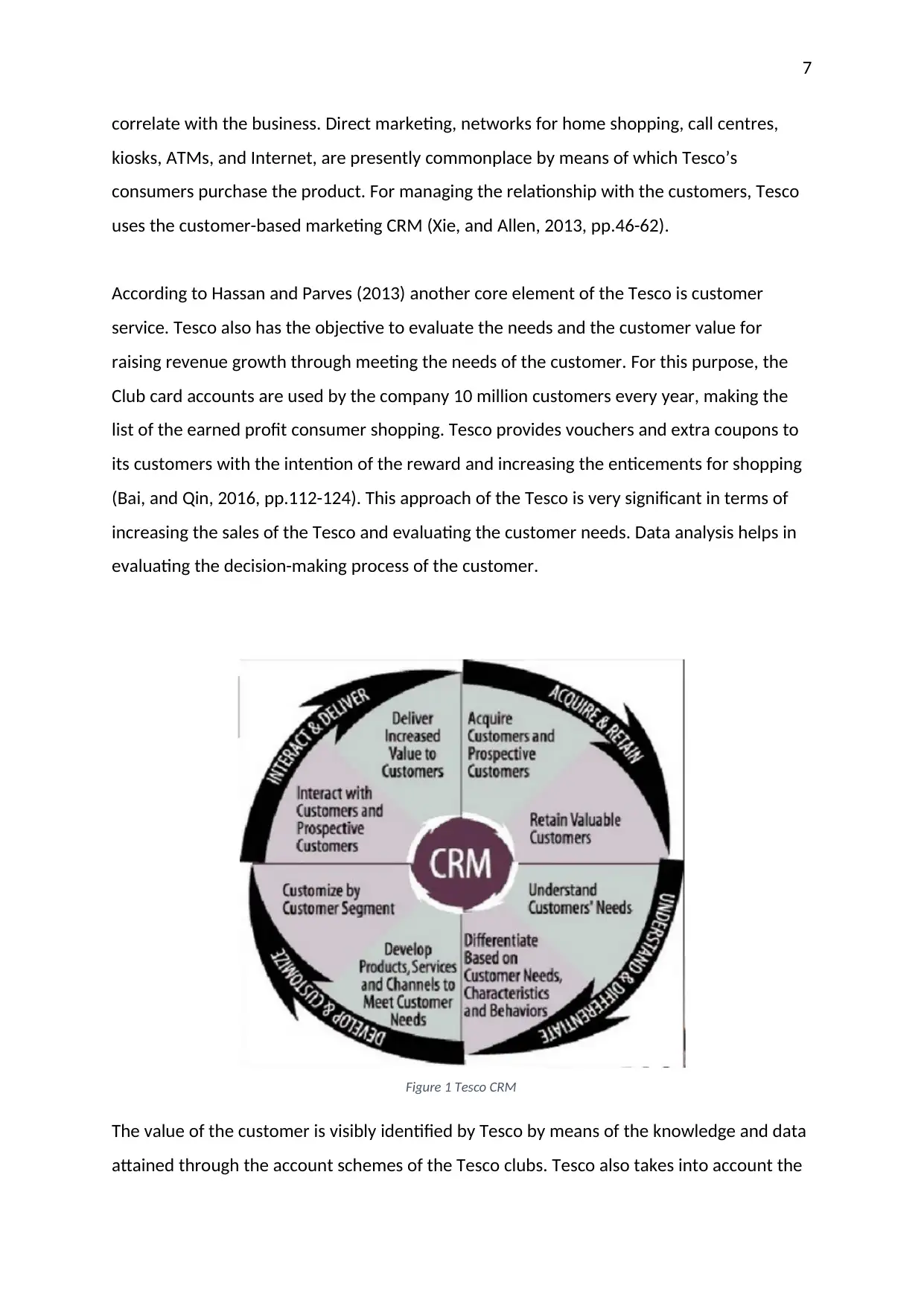
7
correlate with the business. Direct marketing, networks for home shopping, call centres,
kiosks, ATMs, and Internet, are presently commonplace by means of which Tesco’s
consumers purchase the product. For managing the relationship with the customers, Tesco
uses the customer-based marketing CRM (Xie, and Allen, 2013, pp.46-62).
According to Hassan and Parves (2013) another core element of the Tesco is customer
service. Tesco also has the objective to evaluate the needs and the customer value for
raising revenue growth through meeting the needs of the customer. For this purpose, the
Club card accounts are used by the company 10 million customers every year, making the
list of the earned profit consumer shopping. Tesco provides vouchers and extra coupons to
its customers with the intention of the reward and increasing the enticements for shopping
(Bai, and Qin, 2016, pp.112-124). This approach of the Tesco is very significant in terms of
increasing the sales of the Tesco and evaluating the customer needs. Data analysis helps in
evaluating the decision-making process of the customer.
Figure 1 Tesco CRM
The value of the customer is visibly identified by Tesco by means of the knowledge and data
attained through the account schemes of the Tesco clubs. Tesco also takes into account the
correlate with the business. Direct marketing, networks for home shopping, call centres,
kiosks, ATMs, and Internet, are presently commonplace by means of which Tesco’s
consumers purchase the product. For managing the relationship with the customers, Tesco
uses the customer-based marketing CRM (Xie, and Allen, 2013, pp.46-62).
According to Hassan and Parves (2013) another core element of the Tesco is customer
service. Tesco also has the objective to evaluate the needs and the customer value for
raising revenue growth through meeting the needs of the customer. For this purpose, the
Club card accounts are used by the company 10 million customers every year, making the
list of the earned profit consumer shopping. Tesco provides vouchers and extra coupons to
its customers with the intention of the reward and increasing the enticements for shopping
(Bai, and Qin, 2016, pp.112-124). This approach of the Tesco is very significant in terms of
increasing the sales of the Tesco and evaluating the customer needs. Data analysis helps in
evaluating the decision-making process of the customer.
Figure 1 Tesco CRM
The value of the customer is visibly identified by Tesco by means of the knowledge and data
attained through the account schemes of the Tesco clubs. Tesco also takes into account the

8
profit of the company simultaneously by evaluating the consumer’s data in a haphazard
manner. Along with the awareness related to the profit as a loss account for measure the
consumer investments within the scheme, the resource evaluation is performed within the
Tesco along with the customer value and the extra return created. By means of this
strategy, the customers of Tesco get attracted to the business and this also aids in increasing
the demands of the products of the Tesco. By viewing this approach of Tesco multiple
companies are trying to plot different strategies for their companies.
One of the major objectives of the CRM strategy of Tesco is to sustain the enduring
relationship with the customer and increase the loyalty level. Especially the Idea of the Club
card introduced by Tesco as consumers can use the membership through Club card. The
reason behind the Club card is to allow the consumer to collect the points while they are at
Tesco and by using these points, they can buy some more products. This is, however, one of
the great strategies of Tesco for maintaining customer relationships.
Though, as compared to the competitors of Tesco, Tesco provides these benefits routinely
and there is no specific day set for attaining benefits such as birthdays. Along with this, the
competitors of Tesco have their membership occasion, in this way the customer takes the
benefit of the product. Moreover, the consumers of the majority of the competitors of
Tesco are unable to take benefit from the Club card. Another major aim of Tesco is that it is
focused on increasing the effectiveness and increasing the speed of the queuing procedure
and increase the journey of the customer. Tesco tries to attain the data of customers by
using Data analytics. It is seen that there are multiple companies that don’t take benefit
from this data, though it is vital for enhancing a better relationship with the customer and
maintaining the CRM. There are various places in which CRM is used within the Tesco for
enhancing the efficiency of the work and increasing customer satisfaction. By providing
customer satisfaction, ultimately revenue will be increase.
Customer Analytics
The CRM of the Tesco is followed at the customer facing level. Tesco uses NPS as CRM
analytics metrics. The CRM metrics of the Tesco is based on the 62% of sales through Club
card, 85% of revenue through Club card, and 90% redemption of promotional coupons.
profit of the company simultaneously by evaluating the consumer’s data in a haphazard
manner. Along with the awareness related to the profit as a loss account for measure the
consumer investments within the scheme, the resource evaluation is performed within the
Tesco along with the customer value and the extra return created. By means of this
strategy, the customers of Tesco get attracted to the business and this also aids in increasing
the demands of the products of the Tesco. By viewing this approach of Tesco multiple
companies are trying to plot different strategies for their companies.
One of the major objectives of the CRM strategy of Tesco is to sustain the enduring
relationship with the customer and increase the loyalty level. Especially the Idea of the Club
card introduced by Tesco as consumers can use the membership through Club card. The
reason behind the Club card is to allow the consumer to collect the points while they are at
Tesco and by using these points, they can buy some more products. This is, however, one of
the great strategies of Tesco for maintaining customer relationships.
Though, as compared to the competitors of Tesco, Tesco provides these benefits routinely
and there is no specific day set for attaining benefits such as birthdays. Along with this, the
competitors of Tesco have their membership occasion, in this way the customer takes the
benefit of the product. Moreover, the consumers of the majority of the competitors of
Tesco are unable to take benefit from the Club card. Another major aim of Tesco is that it is
focused on increasing the effectiveness and increasing the speed of the queuing procedure
and increase the journey of the customer. Tesco tries to attain the data of customers by
using Data analytics. It is seen that there are multiple companies that don’t take benefit
from this data, though it is vital for enhancing a better relationship with the customer and
maintaining the CRM. There are various places in which CRM is used within the Tesco for
enhancing the efficiency of the work and increasing customer satisfaction. By providing
customer satisfaction, ultimately revenue will be increase.
Customer Analytics
The CRM of the Tesco is followed at the customer facing level. Tesco uses NPS as CRM
analytics metrics. The CRM metrics of the Tesco is based on the 62% of sales through Club
card, 85% of revenue through Club card, and 90% redemption of promotional coupons.
⊘ This is a preview!⊘
Do you want full access?
Subscribe today to unlock all pages.

Trusted by 1+ million students worldwide
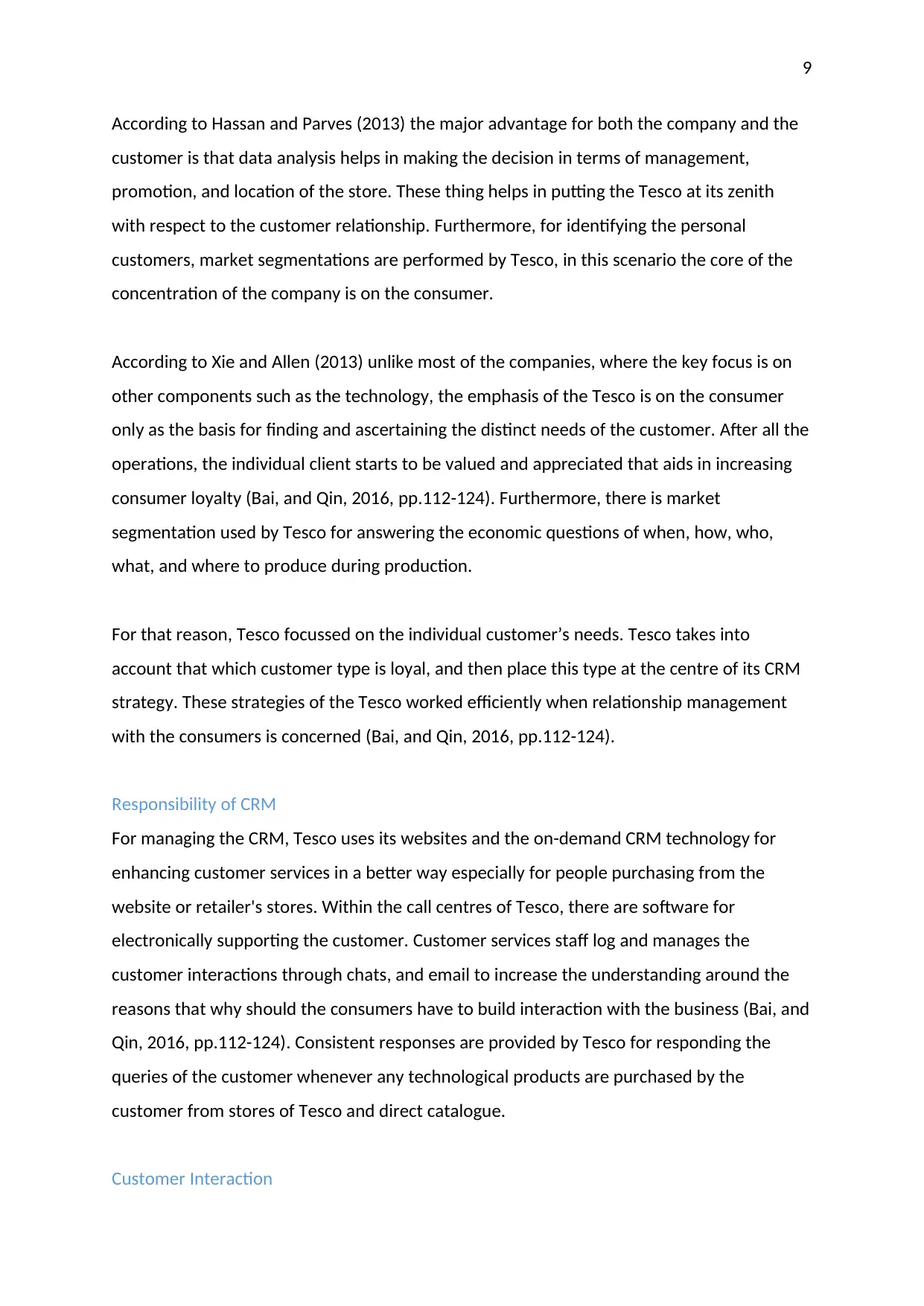
9
According to Hassan and Parves (2013) the major advantage for both the company and the
customer is that data analysis helps in making the decision in terms of management,
promotion, and location of the store. These thing helps in putting the Tesco at its zenith
with respect to the customer relationship. Furthermore, for identifying the personal
customers, market segmentations are performed by Tesco, in this scenario the core of the
concentration of the company is on the consumer.
According to Xie and Allen (2013) unlike most of the companies, where the key focus is on
other components such as the technology, the emphasis of the Tesco is on the consumer
only as the basis for finding and ascertaining the distinct needs of the customer. After all the
operations, the individual client starts to be valued and appreciated that aids in increasing
consumer loyalty (Bai, and Qin, 2016, pp.112-124). Furthermore, there is market
segmentation used by Tesco for answering the economic questions of when, how, who,
what, and where to produce during production.
For that reason, Tesco focussed on the individual customer’s needs. Tesco takes into
account that which customer type is loyal, and then place this type at the centre of its CRM
strategy. These strategies of the Tesco worked efficiently when relationship management
with the consumers is concerned (Bai, and Qin, 2016, pp.112-124).
Responsibility of CRM
For managing the CRM, Tesco uses its websites and the on-demand CRM technology for
enhancing customer services in a better way especially for people purchasing from the
website or retailer's stores. Within the call centres of Tesco, there are software for
electronically supporting the customer. Customer services staff log and manages the
customer interactions through chats, and email to increase the understanding around the
reasons that why should the consumers have to build interaction with the business (Bai, and
Qin, 2016, pp.112-124). Consistent responses are provided by Tesco for responding the
queries of the customer whenever any technological products are purchased by the
customer from stores of Tesco and direct catalogue.
Customer Interaction
According to Hassan and Parves (2013) the major advantage for both the company and the
customer is that data analysis helps in making the decision in terms of management,
promotion, and location of the store. These thing helps in putting the Tesco at its zenith
with respect to the customer relationship. Furthermore, for identifying the personal
customers, market segmentations are performed by Tesco, in this scenario the core of the
concentration of the company is on the consumer.
According to Xie and Allen (2013) unlike most of the companies, where the key focus is on
other components such as the technology, the emphasis of the Tesco is on the consumer
only as the basis for finding and ascertaining the distinct needs of the customer. After all the
operations, the individual client starts to be valued and appreciated that aids in increasing
consumer loyalty (Bai, and Qin, 2016, pp.112-124). Furthermore, there is market
segmentation used by Tesco for answering the economic questions of when, how, who,
what, and where to produce during production.
For that reason, Tesco focussed on the individual customer’s needs. Tesco takes into
account that which customer type is loyal, and then place this type at the centre of its CRM
strategy. These strategies of the Tesco worked efficiently when relationship management
with the consumers is concerned (Bai, and Qin, 2016, pp.112-124).
Responsibility of CRM
For managing the CRM, Tesco uses its websites and the on-demand CRM technology for
enhancing customer services in a better way especially for people purchasing from the
website or retailer's stores. Within the call centres of Tesco, there are software for
electronically supporting the customer. Customer services staff log and manages the
customer interactions through chats, and email to increase the understanding around the
reasons that why should the consumers have to build interaction with the business (Bai, and
Qin, 2016, pp.112-124). Consistent responses are provided by Tesco for responding the
queries of the customer whenever any technological products are purchased by the
customer from stores of Tesco and direct catalogue.
Customer Interaction
Paraphrase This Document
Need a fresh take? Get an instant paraphrase of this document with our AI Paraphraser
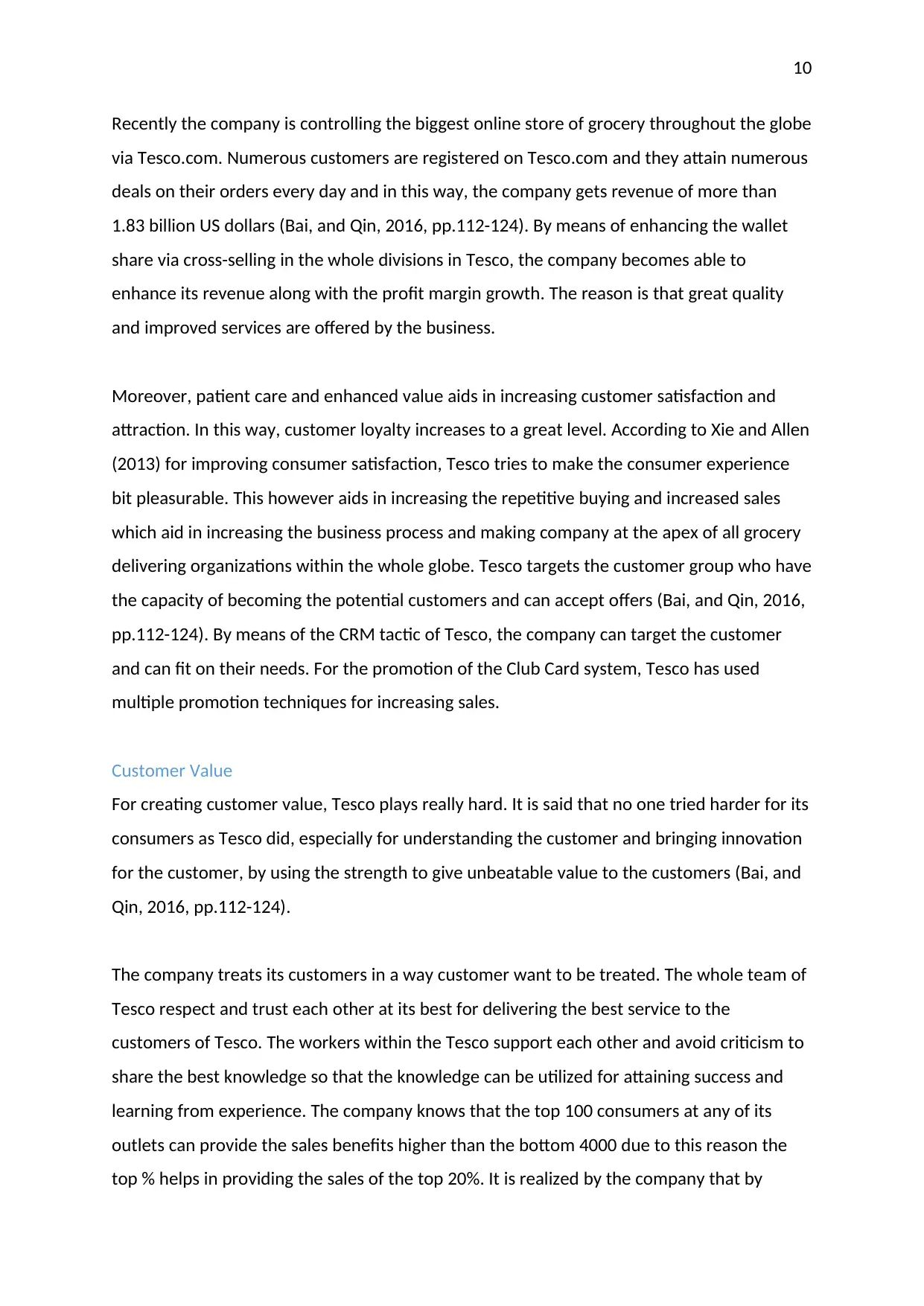
10
Recently the company is controlling the biggest online store of grocery throughout the globe
via Tesco.com. Numerous customers are registered on Tesco.com and they attain numerous
deals on their orders every day and in this way, the company gets revenue of more than
1.83 billion US dollars (Bai, and Qin, 2016, pp.112-124). By means of enhancing the wallet
share via cross-selling in the whole divisions in Tesco, the company becomes able to
enhance its revenue along with the profit margin growth. The reason is that great quality
and improved services are offered by the business.
Moreover, patient care and enhanced value aids in increasing customer satisfaction and
attraction. In this way, customer loyalty increases to a great level. According to Xie and Allen
(2013) for improving consumer satisfaction, Tesco tries to make the consumer experience
bit pleasurable. This however aids in increasing the repetitive buying and increased sales
which aid in increasing the business process and making company at the apex of all grocery
delivering organizations within the whole globe. Tesco targets the customer group who have
the capacity of becoming the potential customers and can accept offers (Bai, and Qin, 2016,
pp.112-124). By means of the CRM tactic of Tesco, the company can target the customer
and can fit on their needs. For the promotion of the Club Card system, Tesco has used
multiple promotion techniques for increasing sales.
Customer Value
For creating customer value, Tesco plays really hard. It is said that no one tried harder for its
consumers as Tesco did, especially for understanding the customer and bringing innovation
for the customer, by using the strength to give unbeatable value to the customers (Bai, and
Qin, 2016, pp.112-124).
The company treats its customers in a way customer want to be treated. The whole team of
Tesco respect and trust each other at its best for delivering the best service to the
customers of Tesco. The workers within the Tesco support each other and avoid criticism to
share the best knowledge so that the knowledge can be utilized for attaining success and
learning from experience. The company knows that the top 100 consumers at any of its
outlets can provide the sales benefits higher than the bottom 4000 due to this reason the
top % helps in providing the sales of the top 20%. It is realized by the company that by
Recently the company is controlling the biggest online store of grocery throughout the globe
via Tesco.com. Numerous customers are registered on Tesco.com and they attain numerous
deals on their orders every day and in this way, the company gets revenue of more than
1.83 billion US dollars (Bai, and Qin, 2016, pp.112-124). By means of enhancing the wallet
share via cross-selling in the whole divisions in Tesco, the company becomes able to
enhance its revenue along with the profit margin growth. The reason is that great quality
and improved services are offered by the business.
Moreover, patient care and enhanced value aids in increasing customer satisfaction and
attraction. In this way, customer loyalty increases to a great level. According to Xie and Allen
(2013) for improving consumer satisfaction, Tesco tries to make the consumer experience
bit pleasurable. This however aids in increasing the repetitive buying and increased sales
which aid in increasing the business process and making company at the apex of all grocery
delivering organizations within the whole globe. Tesco targets the customer group who have
the capacity of becoming the potential customers and can accept offers (Bai, and Qin, 2016,
pp.112-124). By means of the CRM tactic of Tesco, the company can target the customer
and can fit on their needs. For the promotion of the Club Card system, Tesco has used
multiple promotion techniques for increasing sales.
Customer Value
For creating customer value, Tesco plays really hard. It is said that no one tried harder for its
consumers as Tesco did, especially for understanding the customer and bringing innovation
for the customer, by using the strength to give unbeatable value to the customers (Bai, and
Qin, 2016, pp.112-124).
The company treats its customers in a way customer want to be treated. The whole team of
Tesco respect and trust each other at its best for delivering the best service to the
customers of Tesco. The workers within the Tesco support each other and avoid criticism to
share the best knowledge so that the knowledge can be utilized for attaining success and
learning from experience. The company knows that the top 100 consumers at any of its
outlets can provide the sales benefits higher than the bottom 4000 due to this reason the
top % helps in providing the sales of the top 20%. It is realized by the company that by
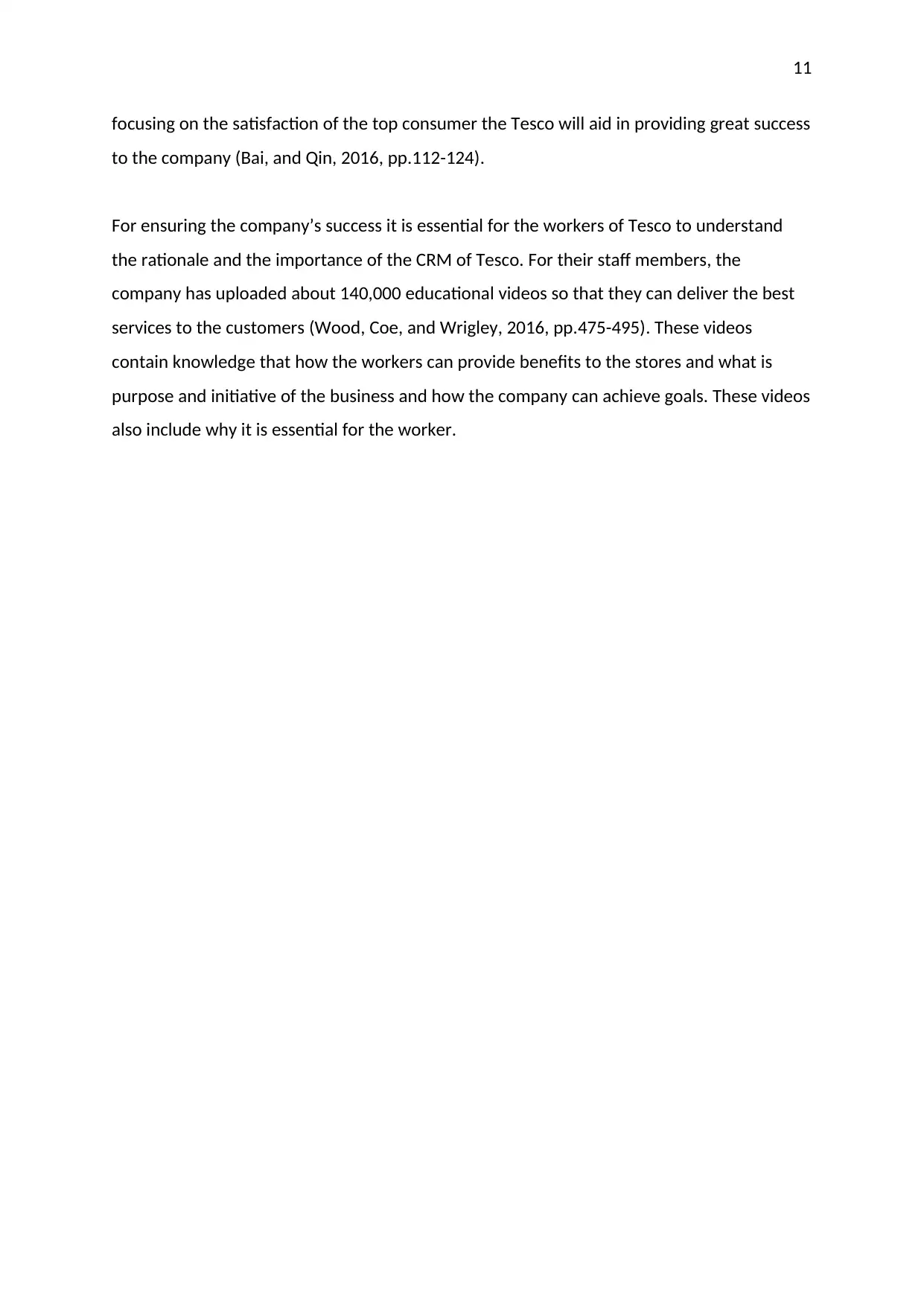
11
focusing on the satisfaction of the top consumer the Tesco will aid in providing great success
to the company (Bai, and Qin, 2016, pp.112-124).
For ensuring the company’s success it is essential for the workers of Tesco to understand
the rationale and the importance of the CRM of Tesco. For their staff members, the
company has uploaded about 140,000 educational videos so that they can deliver the best
services to the customers (Wood, Coe, and Wrigley, 2016, pp.475-495). These videos
contain knowledge that how the workers can provide benefits to the stores and what is
purpose and initiative of the business and how the company can achieve goals. These videos
also include why it is essential for the worker.
focusing on the satisfaction of the top consumer the Tesco will aid in providing great success
to the company (Bai, and Qin, 2016, pp.112-124).
For ensuring the company’s success it is essential for the workers of Tesco to understand
the rationale and the importance of the CRM of Tesco. For their staff members, the
company has uploaded about 140,000 educational videos so that they can deliver the best
services to the customers (Wood, Coe, and Wrigley, 2016, pp.475-495). These videos
contain knowledge that how the workers can provide benefits to the stores and what is
purpose and initiative of the business and how the company can achieve goals. These videos
also include why it is essential for the worker.
⊘ This is a preview!⊘
Do you want full access?
Subscribe today to unlock all pages.

Trusted by 1+ million students worldwide
1 out of 31
Related Documents
Your All-in-One AI-Powered Toolkit for Academic Success.
+13062052269
info@desklib.com
Available 24*7 on WhatsApp / Email
![[object Object]](/_next/static/media/star-bottom.7253800d.svg)
Unlock your academic potential
Copyright © 2020–2025 A2Z Services. All Rights Reserved. Developed and managed by ZUCOL.





